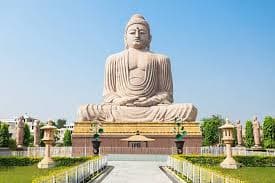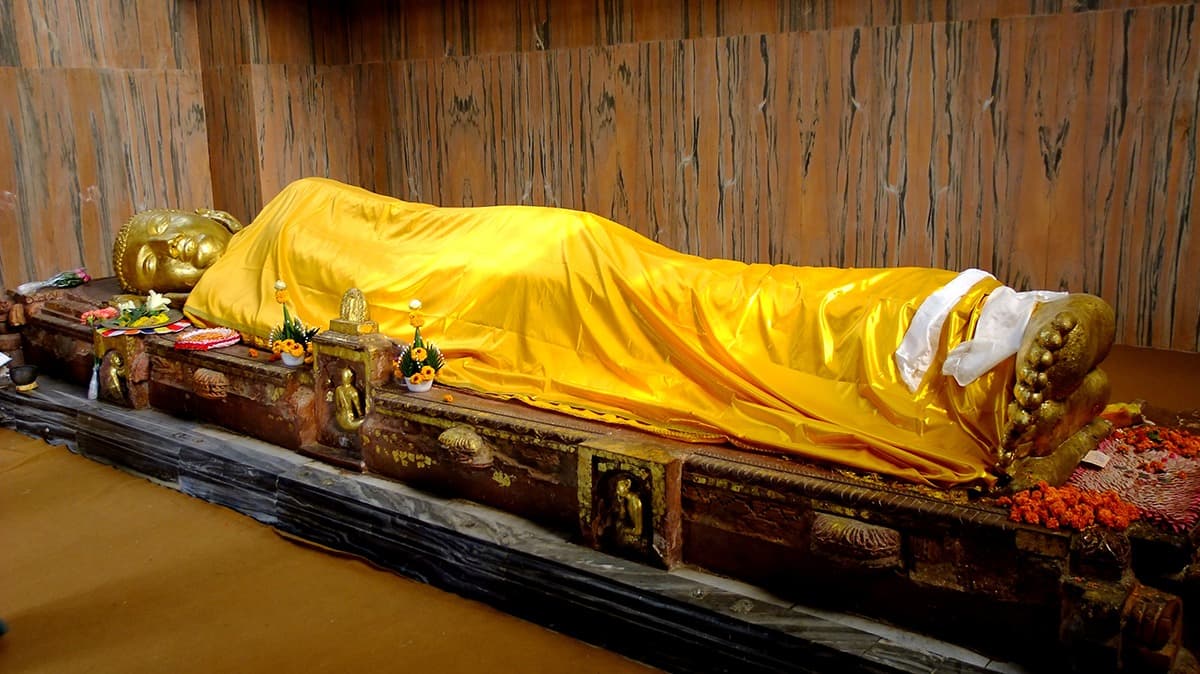Places ofReverence
The four places a pious person should visit and look upon with feelings of reverence — thoughtfully presented for study, reflection, and pilgrimage.
A Passage for Contemplation
"Here the Tathāgata was born. Here the Tathāgata became fully enlightened in unsurpassed, supreme Enlightenment. Here the Tathāgata set rolling the unexcelled Wheel of the Dhamma. Here the Tathāgata passed away into the state of Nibbāna in which no element of clinging remains."
These are the four places that a pious person should visit and look upon with feelings of reverence.
The Four Sacred Places
Each location marks a pivotal moment in the Buddha's life and offers unique opportunities for reflection and spiritual growth.

Lumbinī — The Birthplace
“Here the Tathāgata was born.”
Lumbinī is remembered as the sacred spot where the Tathāgata came into the world. Pilgrims visit with reverence and reflect on the miracle of life and awakening.

Bodhgaaya — The Enlightenment
“Here the Tathāgata became fully enlightened in unsurpassed, supreme Enlightenment.”
At Bodhgaaya the Buddha sat under the Bodhi tree and awakened completely. This place inspires those who practice the path toward clarity and freedom.

Sārnāth — The First Teaching
“Here the Tathāgata set rolling the unexcelled Wheel of the Dhamma.”
Sārnāth marks the moment the Dhamma was first taught — the opening of the path for others. Pilgrims come to connect with wise speech and practice.

Kusinārā (Kushinagar) — Parinibbāna
“Here the Tathāgata passed away into the state of Nibbāna in which no element of clinging remains.”
Kusinārā is honored as the place of the Buddha's passing into final liberation — a place for deep contemplation on impermanence and peace.
Original Text
Dīgha Nikāya – Mahāparinibbāna Sutta
Pāli Version
Cattari mani ananda saddhassa kulaputtassa dassaniyani samvejaniyani thanani katamani chattari?
- 1. 'Idha tathāgato jāto' ti Ānanda, saddhassa kulaputtassa dassanīyaṁ samvejanīyaṁ ṭhānaṁ.
- 2. 'Idha tathāgato anuttaraṁ sammāsambodhiṁ abhisambuddho' ti Ānanda, saddhassa kulaputtassa dassanīyaṁ samvejanīyaṁ ṭhānaṁ.
- 3. 'Idha tathāgatena anuttaraṁ dhammacakkam pavattitaṁ' ti Ānanda, saddhassa kulaputtassa dassanīyaṁ samvejanīyaṁ ṭhānaṁ.
- 4. 'Idha tathāgato anupādisesāya nibbānadhātuyā parinibbuto' ti Ānanda, saddhassa kulaputtassa dassanīyaṁ samvejanīyaṁ ṭhānaṁ.
Imāni kho Ānanda cattāri saddhassa kulaputtassa dassanīyāni samvejanīyāni ṭhānāni. Āgamissanti kho Ānanda saddhā bhikkhū bhikkhuniyo upāsakā upāsikāyo 'idha tathāgato jāto' ti pi, 'idha tathāgato anuttaraṁ sammāsambodhiṁ abhisambuddho' ti pi, 'idha tathāgatena anuttaraṁ dhammacakkam pavattitaṁ' ti pi, 'idha tathāgato anupādisesāya nibbānadhātuyā parinibbuto' ti pi; ye hi keci Ānanda cetiyacārikaṁ āhiṇḍantā pasannacittā kālaṁ karissanti, sabbe te kāyassa bhedā paraṁ maraṇā sugatiṁ saggaṁ lokaṁ upapajjissanti.
English Translation
There are four places, Ānanda, that a pious person should visit and look upon with feelings of reverence. What are the four?
- 1. "Here the Tathāgata was born." This, Ānanda, is a place that a pious person should visit and look upon with feelings of reverence.
- 2. "Here the Tathāgata became fully enlightened in unsurpassed, supreme Enlightenment." This, Ānanda, is a place that a pious person should visit and look upon with feelings of reverence.
- 3. "Here the Tathāgata set rolling the unexcelled Wheel of the Dhamma." This, Ānanda, is a place that a pious person should visit and look upon with feelings of reverence.
- 4. "Here the Tathāgata passed away into the state of Nibbāna in which no element of clinging remains." This, Ānanda, is a place that a pious person should visit and look upon with feelings of reverence.
"These, Ānanda, are the four places that a pious person should visit and look upon with feelings of reverence. And truly there will come to these places, Ānanda, pious bhikkhus and bhikkhunis, laymen and laywomen, reflecting: 'Here the Tathāgata was born; here the Tathāgata became fully enlightened in unsurpassed, supreme Enlightenment; here the Tathāgata set rolling the unexcelled Wheel of the Dhamma; here the Tathāgata passed away into the state of Nibbāna in which no element of clinging remains.' And whoever, Ānanda, should die on such a pilgrimage with a heart established in faith, at the breaking up of the body, after death, will be reborn in a realm of heavenly happiness."
Reflection for the Pilgrim
Guidance for meaningful pilgrimage and deep contemplation at these sacred sites.
Set Clear Intention
Begin your journey with mindful purpose and pure motivation for spiritual growth.
Practice Mindful Presence
Maintain respectful silence and deep listening at each sacred location.
Offer Generosity
Perform acts of dāna and care at each site to cultivate generosity.
Begin Your Spiritual Journey
Whether through physical pilgrimage or contemplative study, may these sacred places inspire your practice and deepen your understanding of the Dhamma.